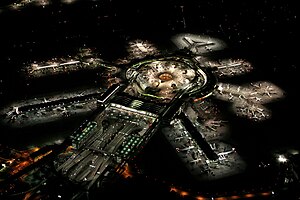
Back Internasionale lughawe Afrikaans مطار دولي Arabic Aeropuertu internacional AST Beynəlxalq hava limanı Azerbaijani इंटरनेशनल हवाईअड्डा Bihari আন্তর্জাতিক বিমানবন্দর Bengali/Bangla Aeroport internacional Catalan Mezinárodní letiště Czech Maes awyr rhyngwladol Welsh Διεθνές αεροδρόμιο Greek

An international airport is an airport with customs and border control facilities enabling passengers to travel between countries. International airports are usually larger than domestic airports, and feature longer runways and have facilities to accommodate heavier aircraft such as the Boeing 747 and the Airbus A380 commonly used for international and intercontinental travel. International airports often host domestic flights, which helps feed both passengers and cargo into international ones (and vice versa).

Buildings, operations, and management have become increasingly sophisticated since the mid-20th century, when international airports began to provide infrastructure for international civilian flights. Detailed technical standards have been developed to ensure safety and common coding systems implemented to provide global consistency. The physical structures that serve millions of individual passengers and flights are among the most complex and interconnected in the world. By the second decade of the 21st century, over 1,200 international[citation needed] airports existed with around 3.8 billion[1] international passengers as of January 2023 along with 50 million[citation needed] metric tonnes of cargo passing through them annually.
- ^ "The world's airports – the state of the industry in Jan-2023 in 11 numbers". CAPA - Centre for Aviation. Retrieved 11 January 2024.